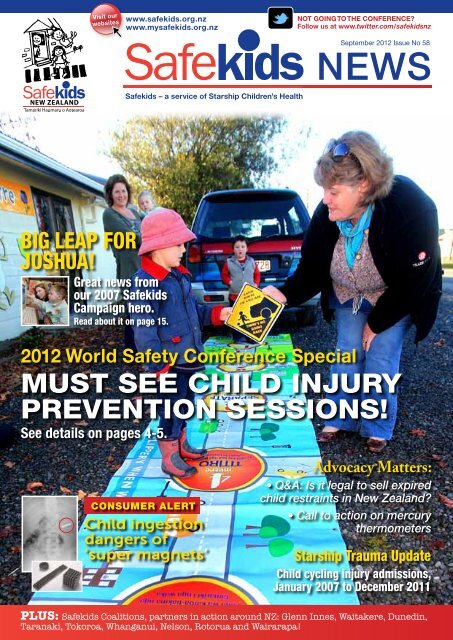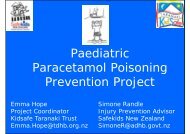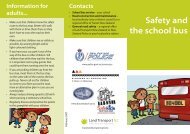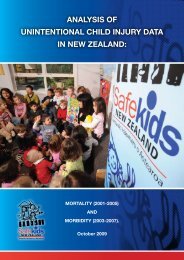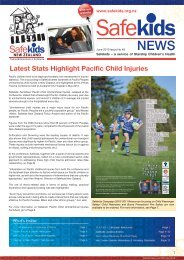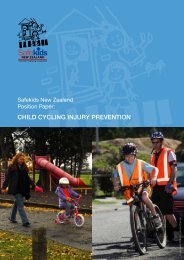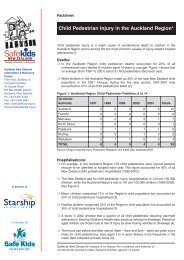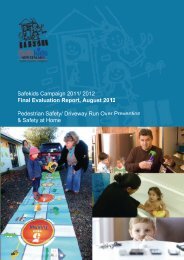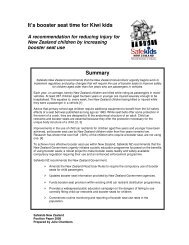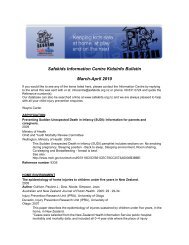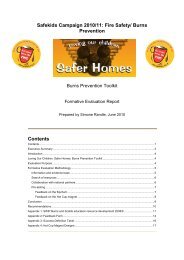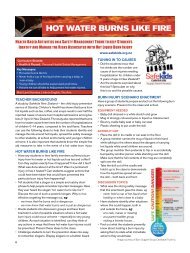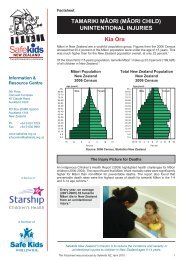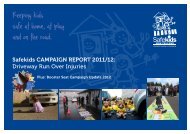MUST SEE CHILD INJURY PREVENTION SESSIONS! - Safekids
MUST SEE CHILD INJURY PREVENTION SESSIONS! - Safekids
MUST SEE CHILD INJURY PREVENTION SESSIONS! - Safekids
Create successful ePaper yourself
Turn your PDF publications into a flip-book with our unique Google optimized e-Paper software.
Visit our<br />
websites<br />
www.safekids.org.nz<br />
www.mysafekids.org.nz<br />
NOT GOING TO THE CONFERENCE?<br />
Follow us at www.twitter.com/safekidsnz<br />
September 2012 Issue No 58<br />
NEWS<br />
<strong>Safekids</strong> – a service of Starship Children’s Health<br />
BIG LEAP FOR<br />
JOSHUA!<br />
Great news from<br />
our 2007 <strong>Safekids</strong><br />
Campaign hero.<br />
Read about it on page 15.<br />
2012 World Safety Conference Special<br />
<strong>MUST</strong> <strong>SEE</strong> <strong>CHILD</strong> <strong>INJURY</strong><br />
<strong>PREVENTION</strong> <strong>SESSIONS</strong>!<br />
See details on pages 4-5.<br />
CONSUMER ALERT<br />
Child ingestion<br />
dangers of<br />
‘super magnets’<br />
Advocacy Matters:<br />
• Q&A: Is it legal to sell expired<br />
child restraints in New Zealand?<br />
• Call to action on mercury<br />
thermometers<br />
Starship Trauma Update<br />
Child cycling injury admissions,<br />
January 2007 to December 2011<br />
PLUS: <strong>Safekids</strong> Coalitions, partners in action around NZ: Glenn Innes, Waitakere, Dunedin,<br />
Taranaki, Tokoroa, Whanganui, Nelson, Rotorua and Wairarapa!
MESSAGE FROM THE DIRECTOR<br />
Welcome to delegates of the 2012 World Safety Conference!<br />
The 11th World Conference on Injury Prevention and<br />
Safety Promotion (Safety 2012) is finally here. On behalf<br />
of the <strong>Safekids</strong> New Zealand team, I would like welcome<br />
all delegates from across New Zealand and around the<br />
world, and in particular to our colleagues from the Safe<br />
Kids Worldwide member countries.<br />
Working in child injury prevention, while very rewarding, can also<br />
be a challenge. This is especially true for those of us who work with<br />
at-risk communities or with vulnerable families and children.<br />
Working in collaboration with the right partners is essential. This is<br />
why Safety 2012’s theme Connecting pathways for a vibrant and<br />
safer future will be of help to child injury prevention workers.<br />
Aside from learning new skills from some of the world’s best injury<br />
prevention and safety researchers, Safety 2012 is also a venue to<br />
make mutually beneficial connections with others who share the<br />
same goals.<br />
We hope that after attending Safety 2012, you return inspired, reenergised<br />
and with new networks, ready to take on the challenge<br />
of keeping your countries and communities safe, particularly for<br />
children.<br />
We look forward to meeting you at Safety 2012, and seeing you<br />
at the <strong>Safekids</strong> NZ and Safe Kids WW stands (#10 and 14).<br />
Sincerely,<br />
Ann Weaver<br />
Director,<br />
<strong>Safekids</strong> New Zealand<br />
Keeping Auckland District Health Board<br />
kids safe. <strong>Safekids</strong> recently installed<br />
run over warning signs at Auckland City<br />
Hospital and at Greenlane Clinical Centre.<br />
The signs are located near the crèche in<br />
both sites. We would like to thank Starship<br />
General Manager Fionnagh Dougan and<br />
the Starship Senior Management Team for<br />
supporting this project.<br />
<strong>Safekids</strong> New Zealand thanks the following organisations for<br />
supporting the delivery of the 2012 Information & Planning<br />
Day Workshops Series and the <strong>Safekids</strong> Campaign focusing<br />
on Child Cycling Safety & Safety Out & About.<br />
Major sponsor:<br />
In participation with:<br />
Cover: The <strong>Safekids</strong> Driveway Kit in Marlborough.<br />
Plunket Blenheim’s Maureen Van gelder talks to<br />
4-year old Daniel Brand about safety around vehicles.<br />
Photo credit: Marlborough Express.<br />
2<br />
<strong>Safekids</strong> News is <strong>Safekids</strong> NZ’s quarterly publication.<br />
For enquiries, contact the editor at anthony.rola@adhb.govt.nz.<br />
<strong>Safekids</strong> News encourages discussion within the injury prevention<br />
community. Opinion articles or articles with bylines reflect the<br />
views of the author alone, and do not necessarily reflect the views<br />
of <strong>Safekids</strong> New Zealand<br />
About <strong>Safekids</strong> New Zealand<br />
<strong>Safekids</strong> New Zealand is the injury prevention service of Starship<br />
Children’s Health and a member of Safe Kids Worldwide. Our<br />
mission is to reduce the incidence and severity of unintentional<br />
injuries to children in New Zealand aged 0 - 14 years.<br />
<strong>Safekids</strong> NZ Team<br />
Ann Weaver, Director<br />
Anthony Rola, Marketing and Communications<br />
Blackie Tohiariki, Special Projects Coordinator<br />
Chantal Woodfine, Sponsorship Manager<br />
Gervaise Ledger, Team Support<br />
Joanna Milne, PA to the Director<br />
Moses Alatini, Policy Analyst<br />
Patricia Bolton, Policy Analyst<br />
Sara Bennett, Senior Policy Advisor<br />
Simone Randle, Injury Prevention Advisor<br />
Victoria Jarvis, Coalition Coordinator<br />
Wayne Carter, Information Specialist<br />
Make a difference<br />
<strong>Safekids</strong> New Zealand encourages the involvement of<br />
government, community, industry, decision makers and families<br />
in child safety. If you would like to know more about us, wish to<br />
advocate on behalf of children in your community,<br />
or partner in a programme with us, contact us at:<br />
<strong>Safekids</strong> New Zealand<br />
Fifth Floor, Cornwall Complex,<br />
40 Claude Road, Epsom, Auckland 1023<br />
PO Box 26488, Epsom, Auckland 1344<br />
New Zealand.<br />
Telephone: +64-9 630 9955<br />
Fax: +64-9-630 9961<br />
www.safekids.org.nz<br />
<strong>Safekids</strong> News: September 2012 Issue No 58
Major sponsor<br />
In partnership with<br />
EVENTS<br />
Porirua<br />
Masterton<br />
2012 <strong>Safekids</strong><br />
Campaign workshops<br />
a success<br />
Whangarei<br />
By Simone Randle, <strong>Safekids</strong> NZ Injury<br />
Prevention Advisor<br />
Palmerston North<br />
Nelson<br />
Lower Hutt<br />
The 2012 <strong>Safekids</strong> Campaign Information<br />
& Planning Workshops have ended, and on<br />
behalf of the team, I would like to send heart<br />
felt thanks to all the attendees, coordinators,<br />
guest speakers and to our major sponsor, the<br />
Starship Foundation.<br />
In summary, 25 workshops were held across the<br />
country, with over 400 attendees from the road<br />
safety sector, social and family support services,<br />
health services, Police, Government and Local<br />
Government.<br />
New Plymouth<br />
Whanganui<br />
Pacific<br />
We also had iwi-based organisations, Pacific<br />
Peoples services, sports and leisure centres,<br />
migrant and refugee communities, Plunket,<br />
early childhood education, after school holiday<br />
programmes and retailers, amongst others.<br />
Driveway Run Over, Home Safety report<br />
now available.<br />
North Shore<br />
Blenheim<br />
Māori<br />
The evaluation report for the 2011/ 2012 <strong>Safekids</strong><br />
Campaign (Driveway Run over and Home Safety) is now<br />
available. Thank you to all the practitioners, parents and<br />
members of the public who provided feedback to the<br />
evaluation process. To download this (under reports), visit:<br />
www.safekids.org.nz/index.php/page/Position_Papers<br />
<strong>Safekids</strong> a ‘Finalist’ at the 2012<br />
International Safety Media Awards<br />
The <strong>Safekids</strong> Campaign will be recognised for excellence in media<br />
and communications at the 2012 International Safety Media Awards<br />
(ISMA) which will be held at the closing ceremony of the Safety 2012<br />
World Conference in Wellington.<br />
The awards website describes the<br />
competition as “an opportunity to<br />
share what is being done around the<br />
world, for all of us to learn from our<br />
colleagues, and to celebrate positive<br />
media messages.”<br />
For delegates attending the conference,<br />
the closing ceremony will be held from<br />
2:30-4:20PM (4 October 2012), with<br />
the presentation to the ISMA awardees<br />
from approximately 3:20-3:35PM.<br />
<strong>Safekids</strong> NZ has also been invited to<br />
participate in a session earlier that day,<br />
from 12:30-1:30, during which finalists<br />
will have an opportunity to show at least<br />
part of their entries and briefly describe<br />
their project.<br />
<strong>Safekids</strong> New Zealand has been gaining<br />
numerous awards for its child injury<br />
prevention campaigns, particularly on<br />
passenger safety and driveway run over<br />
prevention. <strong>Safekids</strong> won the Local<br />
Authority Traffic Institute (Trafinz) 2011<br />
Leadership Award for Transport Safety,<br />
and has also been named a finalist<br />
at the 2011 and 2012 New Zealand<br />
Marketing Awards.<br />
For more information about the ISMA<br />
awards, or about the<br />
<strong>Safekids</strong> Campaign, visit<br />
www.alaska-ipc.org/isma/<br />
www.mysafekids.org.nz<br />
www.safekids.org.nz/index.<br />
php/page/campaigns<br />
KNOW WHERE THE KIDS ARE<br />
BEFORE GETTING IN THE CAR<br />
THERE’S NO GOING<br />
P<br />
P<br />
P<br />
CHECK<br />
for children before driving off<br />
SUPERVISE<br />
children around vehicles–always<br />
SEPARATE<br />
play areas from driveways<br />
www.safekids.org.nz<br />
3<br />
<strong>Safekids</strong> News: September 2012 Issue No 58
Scan this QR Code<br />
or visit www.<br />
mysafekids.org.<br />
nz to watch some<br />
of <strong>Safekids</strong> New<br />
Zealand’s Guerilla<br />
Marketing ideas.<br />
Background<br />
Unintentional childhood injury is a serious but neglected public<br />
health issue in New Zealand. The casualties are high (two children<br />
killed every week and 8,184 children hospitalised every year), and the<br />
economic burden is immense – it cost the government NZ$146.6<br />
million in child injury claims during the 2007/2008 financial year.<br />
Unintentional childhood injury is not seen as a priority issue, has few<br />
allies, and receives little support or recognition.<br />
The injury prevention workforce is facing an uphill battle, and <strong>Safekids</strong>,<br />
the child injury prevention service for New Zealand, is forced to<br />
pursue conventional goals with unconventional methods – using<br />
Guerrilla Marketing tactics.<br />
What is Guerrilla Marketing?<br />
Guerrilla Marketing is an effective public health tool used when<br />
funding or resources are limited or non-existent. It’s thinking outside<br />
the box, finding solutions to communicate public health issues beyond<br />
TV commercials and print ads.<br />
Guerilla Marketing is an investment on time, creativity and imagination.<br />
When done effectively, the results are memorable campaigns that cut<br />
through the clutter and leave an indelible mark among its audiences.<br />
Results/Outcome<br />
Guerrilla Marketing played an important role in promoting child<br />
passenger safety and driveway run over prevention messages during<br />
the 2009-2011 <strong>Safekids</strong> Campaign:<br />
✓ TRAFINZ Road Safety Leadership Award (2011).<br />
✓ FINALIST, New Zealand Marketing Awards (2011 and 2012).<br />
✓ Boosters Seats in Safer Journeys - <strong>Safekids</strong> moved the government<br />
to consider a booster seat law in its road safety strategy to 2020,<br />
Safer Journeys.<br />
The Higher You Sit, the Safer the Fit<br />
(Passenger Safety Campaign)<br />
How old should kids be before they give up their booster<br />
seats and just use adult seat belts? Is it five years old? Seven?<br />
Or is it around 12?<br />
The truth is, it’s not how old your kids are, it’s how tall they are.<br />
Wrong<br />
Correct<br />
A seat belt that doesn’t fit properly can cause severe head,<br />
spine and abdominal injuries in a crash.<br />
So remember, keep your kids in a booster seat until they’re<br />
148cm tall. Because the higher they sit, the safer the fit.<br />
For more information, visit www.safekids.org.nz<br />
小 孩 多 少 岁 可 以 不 再 用 防 护 座 椅 ,<br />
而 开 始 使 用 成 年 人 用 的 安 全 带 ? 5 岁 ?<br />
7 岁 或 者 12 岁 左 右 ?<br />
事 实 上 , 这 并 不 是 年 龄 的 问 题 ,<br />
关 键 是 您 的 小 孩 长 到 多 高 。<br />
座 椅 安 全 带 配 戴 不 当 , 发 生 事 故 时 可 能<br />
会 导 致 头 部 、 脊 椎 和 腹 部 严 重 受 伤 。<br />
请 谨 记 , 如 果 您 的 小 孩 身 高 不 到<br />
148 公 分 , 务 必 使 用 防 护 座 椅 。<br />
因 为 小 孩 的 坐 姿 越 高 , 则 越 安 全 。<br />
欲 了 解 更 多 详 情 , 请 访 问 网 站<br />
www.safekids.org.nz.<br />
Booster Rooster (Passenger Safety Campaign)<br />
The NEW <strong>Safekids</strong> Driveway Safety Kit and<br />
Warning Signs (Driveway Run Over Prevention)<br />
WORLD SAFETY CONFERENCE SPECIAL<br />
GUIDE TO SAFETY 2012: 1–4 OCTOBER 2012<br />
<strong>MUST</strong> <strong>SEE</strong> <strong>CHILD</strong> <strong>INJURY</strong> <strong>PREVENTION</strong> <strong>SESSIONS</strong><br />
Safety 2012 is the 11th World Conference on Injury Prevention and<br />
Safety Promotion. Held biennially under the auspices of the World<br />
Health Organization, the 4-day conference features a scientific<br />
programme, an exhibition and a social programme revolving around<br />
the conference theme ‘Connecting pathways for a vibrant and safer<br />
future.’<br />
For those specialising in unintentional child injury prevention,<br />
<strong>Safekids</strong> New Zealand has put together a list of concurrent sessions<br />
to help maximise your attendance at this year’s conference.<br />
Note: Session, dates and times may change. For an up-todate<br />
programme and full session details, visit<br />
Not going to Safety 2012?<br />
<strong>Safekids</strong> NZ is covering<br />
Safety 2012 on Twitter.<br />
Follow us for news, views<br />
and links. Visit:<br />
www.twitter.com/safekidsnz<br />
www.conference.co.nz/worldsafety2012/<br />
TUESDAY 2 OCTOBER 2012<br />
11.00am – 12.30pm Sessions:<br />
1B: Child Safety<br />
• A case-control study of dog bite risk factors in a domestic setting<br />
to children aged 9 years and under. Karen Ashby.<br />
• ‘Revision of Japanese safety standards of bicycle wheel guard<br />
for preventing childhood injury due to wheel spoke’. Tatsuhiro<br />
Yamanaka<br />
• It shouldn’t hurt: Creating policies and places for injury-free active<br />
living for children. Keshia Pollack.<br />
• Using the Integrated Behaviour Change Model (ibcm) to identify<br />
intervention elements for promoting optimal child restraint<br />
practices in New South Wales, Julie Brown.<br />
• Development and Implementation of evidence-based Interventions<br />
for drowning prevention in an expansion site in Dagupan City,<br />
Philippines. Jonathan Guevarra.<br />
• Child injury mortality, socioeconomic status, nationality and<br />
religious affiliation in Israel. Michal Ivancovsky<br />
1D: Product Safety<br />
• The safety information and guidance provided to parents by<br />
all-terrain vehicle dealers and sales representatives, Charles<br />
Jennissen.<br />
• Comparing child product safety concerns with injury incidents:<br />
Does the evidence support the response? Kirsten McKenzie.<br />
• Development of a standard test method for assessing<br />
the firmness of infant sleep surfaces, Ruth Barker.<br />
1F: Collaboration<br />
• Evaluation of the child safety education coalition in England,<br />
Caroline Mulvaney.<br />
12.50pm – 1.20pm Sessions:<br />
• Poster 702.00: Using social media to get<br />
our child injury prevention messages out<br />
there, Wayne Carter.<br />
• Poster 776.00: Guerilla Marketing in Child<br />
Injury Prevention – Winning the war to<br />
keep kids safe in New Zealand,<br />
Anthony Rola.<br />
• Poster 1303.00: Preventing driveway run<br />
over injuries – using research to build a<br />
campaign, Simone Randle.<br />
Guerilla Marketing in Child Injury<br />
Prevention – Winning the war<br />
to keep kids safe in New Zealand<br />
Anthony Rola, <strong>Safekids</strong> New Zealand<br />
• Poster 1316.00: Safety Rocks: Community-based art activity<br />
development to reduce driveway runover trauma, Julie Millar.<br />
2.35pm – 3.35pm Sessions:<br />
2B: Child Safety<br />
• Benchmarking progress on child safety action in Europe - the<br />
results of the 2012 Child Safety Report Cards, Morag MacKay.<br />
• National action plan for child injury prevention – launching a<br />
roadmap for an injury-free childhood, Grant Baldwin.<br />
• Situation of child injuries in Vietnam and interventions, Lan Ngoc<br />
ThiTran.<br />
• Child injury-prevention and the UN convention on the rights of<br />
the child, Elizabeth Towner.<br />
4.00pm – 5.30pm Sessions:<br />
3C: Button Battery Ingestion – addressing an<br />
emerging hazard internationally<br />
• Battery ingestion hazard mitigation, Doug Lee.<br />
• Button batteries - a hidden danger in every home, Martin Rushton<br />
• Regulators study of button batteries: Product designs, warnings and<br />
packaging, John Jamieson<br />
• Modifications of coin cells with anti-ingestion and encapsulation<br />
design features, Jonathan Midgett<br />
• Coin cell battery ingestion hazard mitigation strategies, Jonathan<br />
Midgett<br />
• Coin-sized lithium batteries pose an emerging global burn risk<br />
to children, Angela Mickalide, Kate Carr, Eric Chalmers, Ann<br />
Weaver.<br />
• Design strategies to mitigate the hazard of button<br />
cell battery electrical burn injuries, Gene Rider.<br />
• Preventing lithium coin cell battery ingestion: A<br />
five-pronged strategy, Michael Babiak.<br />
• Energizer’s approach to lithium coin cell battery<br />
ingestion, Michael Babiak, Philip Cooper.<br />
• Resident advocacy to mitigate hazards of button<br />
battery ingestions, James Harisaides.<br />
• Coin battery modification to prevent<br />
gastrointestinal injury from current flow. Eli Baum, Carl Baum.<br />
• Button battery ingestion and insertion by children - an international<br />
approach to an emerging dangerous injury. Eric Chalmers, Ruth<br />
Barker, John Jamieson, Kate Carr, Ann Weaver, Jonathan Midgett,<br />
Martin Rushdon, Mike Shepherd.<br />
• Batteries not included: Identifying disc battery injury in a health<br />
setting, Ruth Barker, Design of a safer lithium coin cell battery,<br />
Jeongbin Ok.<br />
4<br />
<strong>Safekids</strong> News: September 2012 Issue No 58
5 岁 ?7 岁 ? 还 是 12 岁 ?<br />
其 实 应 在 于 孩 子 的 身<br />
高 , 而 非 年 龄 。<br />
安 全 带 若 不 能 扣 紧 发<br />
生 事 故 可 造 成 头 部 、<br />
脊 椎 和 腹 部 严 重 受 伤 。<br />
请 牢 记 : 孩 子 身 高 不 到<br />
148 厘 米 前 , 务 必 使 用<br />
合 适 的 安 全 座 椅 或 加 高<br />
座 椅 。<br />
fit.<br />
WORLD SAFETY CONFERENCE SPECIAL<br />
WEDNESDAY 3 OCTOBER 2012<br />
11.00am – 12.30pm Sessions<br />
4C: Safe Communities<br />
• Safe Community evaluation in terms of child safety, Esmatossadat<br />
Hashemi.<br />
• Promoting safety at work in cooperation with the local community,<br />
Rina Bodankin.<br />
• PRECISE-A model of community participation in Injury prevention<br />
in Bangladesh - implication for other low income countries, Kamran<br />
Ul Baset<br />
4F: Home Safety<br />
• Safety around the home. An interactive, evidence-based guide to<br />
creating a safe home environment, Susanna Eckersley.<br />
• Home injury hazards and home injury in New Zealand, Michael<br />
Keall<br />
• Pacific provider making a difference, Coral Timmins.<br />
2.35pm – 3.35pm Sessions<br />
5B: Child Safety<br />
• Interventional study on middle school students’ bicycle injuries in<br />
the rural area, Li-ping Li.<br />
• Development of assessment tools on safe settings for child and<br />
adolescent injury prevention, Juanita Basilio.<br />
• Acting in the community interest: A sustainable NGO theatre-ineducation<br />
model for delivering child safety education in schools,<br />
David Gribble.<br />
• The Venom Patrol - An online educational resource for improving<br />
health literacy and for snakebite prevention, Ken Winkel.<br />
4.00pm – 5.30pm Concurrent Sessions<br />
6A: Child Safety Workshop<br />
• Behavioural approaches to child injury prevention: Successes,<br />
challenges and future directions, David Schwebel.<br />
• Parenting interventions to prevent unintentional injury: Update<br />
and extension of a Cochrane systematic review, Denise Kendrick.<br />
• Behavioural approaches to child injury prevention: Successes,<br />
challenges and future directions, Andrea Gielen.<br />
• Innovations in child injury prevention: Evidence-based strategies<br />
that address fire safety for young children and playground safety<br />
for older children, Barbara Morrongiello.<br />
6G: Water Safety<br />
• Benchmarking Australian children’s swimming and water safety<br />
skills and knowledge: Challenges and lessons learnt, Amy Peden.<br />
• Children and drowning in Vietnam, An Nguyen Trong.<br />
Throughout the world, almost one million<br />
children die of an injury each year,<br />
and every one of these tragedies is preventable.<br />
THURSDAY 4 OCTOBER 2012<br />
11.00am – 12.30pm Concurrent Sessions<br />
7D: Water Safety<br />
• Policy interventions related to child drowning prevention in low and<br />
middle income countries, Suchada Gerdmongkolgan.<br />
• An overview of drowning in New Zealand and associated research<br />
efforts, Alexander Brunt, Sally Webb.<br />
• Age pattern of drowning mortality across 44 countries, Tsung-Hsueh Lu.<br />
7G: Child Safety; Road Safety<br />
• Stakeholder views and perceptions on epidemiology and<br />
management of childhood and adolescent injuries in north western<br />
Uganda, Milton Mutto.<br />
• Effect-evaluation of web-based, tailored safety information combined<br />
with personal counselling on parents’ child safety behaviours, Mirjam<br />
Van Beelen.<br />
• Determinants of parent perceptions of dangerous traffic related to<br />
school travel, Linda Rothman.<br />
• Cross-cultural comparisons of parents’ knowledge, attitudes<br />
and behaviours related to child safety, Angela Mickalide, Chiedza<br />
Mavengere, Lotte Brondum, Alessandra Francoia.<br />
• Perception of school-bound children’s mothers on road-crossing and<br />
other road-safety issues in Bangladesh, Kazi Selim Anwar.<br />
• Photovoice: Children’s perspectives on road traffic safety in ten<br />
countries. Priti Gautam, Lotte Brondum, Alessandra Francoia,<br />
Theresa Perez.<br />
SAFETY 2012 satellite meetings<br />
Three significant events are also being held in Wellington<br />
before and after Safety 2012: the International Society for<br />
Child and Adolescent Injury Prevention (ISCAIP) Biennial<br />
Meeting (1 October); The Australasian Road Safety Research,<br />
Policing and Education Conference (4-6 October); and the<br />
Public Health Annual Scientific Meeting (ASM, 17–19 October).<br />
<strong>Safekids</strong> New Zealand has been invited to deliver oral and<br />
poster presentations at these events:<br />
• ISCAIP: Purpose Built Data to Tackle Child Unintentional Injury,<br />
by Moses ‘Alatini, <strong>Safekids</strong> New Zealand Policy Analyst.<br />
• ISCAIP Using research to build a campaign (two posters,Child<br />
motor vehicle passenger safety and Preventing driveway run<br />
over injuries) by Simone Randle, <strong>Safekids</strong> New Zealand Injury<br />
Prevention Advisor.<br />
• Australasia Conference: Child motor vehicle passenger safety;<br />
using research to build a campaign, by Simone Randle.<br />
• NZCPHM ASM: Improving child health through the prevention<br />
of unintentional injury: <strong>Safekids</strong> New Zealand reaching<br />
communities to prevent child passenger injury, by Patricia<br />
Bolton, <strong>Safekids</strong> New Zealand Policy Analyst.<br />
Safe Kids works with an extensive network of more than 600 coalitions in the<br />
United States and in 23 countries to reduce traffic injuries, drowning, falls, burns,<br />
poisonings and more. Please join us for a robust exchange of ideas at the<br />
11th World Conference on Injury Prevention and Safety Promotion – look for Safe Kids at Stand 14.<br />
Together we can make a difference in the lives of children around the world.<br />
To learn about Safe Kids Worldwide,<br />
visit: www.safekids.org/worldwide<br />
follow us on facebook: safekidsusa<br />
twitter: @safekidsusa<br />
FREE postcards at<br />
Stand 10 (<strong>Safekids</strong> NZ)<br />
We are giving away themed postcards<br />
at the Safety 2012 conference so<br />
delegates can send child injury<br />
prevention messages to loved ones at<br />
home. There is also a special <strong>Safekids</strong><br />
mailbox at our booth so you can send<br />
the postcards postage free!<br />
HOW OLD SHOULD KIDS BE BEFORE<br />
THEY GIVE UP THEIR CARSEATS AND<br />
BOOSTER SEATS, AND JUST<br />
USE ADULT SEAT BELTS?<br />
Is it five years old? Seven? Or is it around 12?<br />
The truth is, it’s not how old your kids are, it’s how ta l they are.<br />
A seat bel that doesn’t fit properly can cause severe head, spine and abdominal injuries in a<br />
crash. So remember, keep your kids in the right carseat or booster seat until they’re 148cm ta l.<br />
Because the higher they sit, the safer the fit.<br />
KNOW WHERE THE KIDS ARE<br />
BEFORE GETTING IN THE CAR<br />
小 孩 几 岁 可 不 再<br />
坐 安 全 座 椅 或 加<br />
高 座 椅 , 而 只 用<br />
成 人 安 全 带<br />
P<br />
P<br />
P<br />
CHECK<br />
THERE’S NO GOING<br />
for children before driving o f<br />
SUPERVISE<br />
children around vehicles–always<br />
SEPARATE<br />
play areas from driveways<br />
HOW OLD SHOULD KIDS BE BEFORE THEY<br />
GIVE UP THEIR CARSEATS AND BOOSTER<br />
SEATS, AND JUST USE ADULT SEAT BELTS?<br />
Is it five years old?<br />
Seven? Or is it around<br />
12? The truth is, it’s not<br />
how old your kids are,<br />
it’s how ta l they are.<br />
A seat bel that<br />
doesn’t fit properly can<br />
cause severe head,<br />
spine and abdominal<br />
injuries in a crash.<br />
So remember, keep<br />
your kids in the right<br />
carseat or booster seat<br />
until they’re 148cm ta l.<br />
Because the higher<br />
they sit, the safer the<br />
www.mysafekids.org.nz<br />
5<br />
<strong>Safekids</strong> News: September 2012 Issue No 58
ADVOCACY MATTERS<br />
Q&A: Is it legal to sell expired restraints in NZ?<br />
Recently we were asked this question by a concerned individual<br />
who found an expired car seat being sold at a second hand shop.<br />
As we found out, determining the legality of selling expired child<br />
restraints is not a simple ‘black or white’ situation.<br />
In New Zealand, there is nothing in legislation that precludes the<br />
selling of an expired child restraint as such.<br />
Ask Mo’!<br />
Do you have a question<br />
about policies and laws<br />
relating to child safety?<br />
Ask Moses ‘Alatini,<br />
<strong>Safekids</strong> Policy Analyst at:<br />
Moses.Alatini@adhb.govt.nz<br />
However, according to the New Zealand<br />
Transport Agency (NZTA), the Land<br />
Transport Rule: Vehicle Equipment<br />
2004 requires child restraints to be<br />
installed in accordance with the<br />
manufacturer’s instructions.<br />
This means that if a child restraint<br />
is installed in a motor vehicle after<br />
the expiry date specified on the<br />
child restraint, it is therefore a<br />
breach of the rule.<br />
If an expired child restraint was sold by<br />
CALL TO ACTION: Safe disposal of mercury fever<br />
thermometers<br />
By Dr Patricia Bolton, <strong>Safekids</strong> NZ Policy Analyst<br />
a retailer, it could be argued that it was “not fit for purpose” and as<br />
such a breach of the Consumer Guarantees Act.<br />
While it is unclear if selling expired child restraints in New Zealand is<br />
illegal, Safekid’s position on buying child restraints is clear: Do not<br />
buy a child restraint that is past its expiry date.<br />
<strong>Safekids</strong> NZ recommendations when buying a child restraint:<br />
• The child restraint must fit your child and car correctly<br />
• It must meet an approved safety standard<br />
• Check the date when the child restraint was made<br />
• Do not buy a child restraint that is past its expiry date, or is<br />
missing parts.<br />
• Do not buy child restraints without knowing their history.<br />
• Do not use a car seat that has been in a crash<br />
For further information about this topic, or for more <strong>Safekids</strong><br />
information about purchasing and using child restraints, visit:<br />
http://www.nzta.govt.nz/resources/rules/vehicle-equipment-2004-qa.html<br />
www.mysafekids.org.nz/passengersafety<br />
Elemental mercury is a hazardous substance, and releases<br />
toxic vapour when items containing mercury, such as fever<br />
thermometers, are broken 1 . Mercury vapour can cause<br />
significant harm to the brain, nerves, lungs and kidneys 2 , and<br />
children are particularly vulnerable to its toxic effects 3 . Children<br />
can also be injured by mercury fever thermometer glass cuts if<br />
the thermometer glass breaks during use 4 . It is essential that a<br />
spill of mercury is cleaned up and disposed of in a special way<br />
to avoid ongoing exposure to mercury vapour (see Ministry of<br />
Health factsheet 5 ).<br />
The World Health Organization and Health Care Without Harm<br />
have established a global mercury-free initiative to support the<br />
removal of mercury thermometers and sphygmomanometers<br />
from healthcare 6 . Whilst several District Health Boards in<br />
New Zealand have removed mercury-containing items from<br />
hospitals, the high number of mercury spill notifications to<br />
the National Poisons Centre in the past 5 years (466 mercury<br />
spill notifications July 2007-June 2012) indicates that many<br />
New Zealand households continue to use mercury fever<br />
thermometers 7 .<br />
Mercury thermometers must be disposed of at hazardous<br />
waste disposal facilities to avoid mercury re-entering the<br />
food chain through contamination of soil and waterways 8 .<br />
Unfortunately, in many regions of New Zealand access to<br />
hazardous waste disposal facilities is limited by convenience<br />
and expense.<br />
To support the safe disposal of mercury fever thermometers,<br />
<strong>Safekids</strong> NZ and Auckland Regional Public Health Service<br />
are investigating the potential for a national pharmacy based<br />
mercury fever thermometer disposal programme to be set<br />
up. Such a disposal programme would provide New Zealand<br />
families with a more accessible means to safely and responsibly<br />
dispose of mercury fever thermometers as hazardous waste at<br />
their local pharmacy.<br />
Please contact <strong>Safekids</strong> NZ if you are interested in supporting<br />
a mercury fever thermometer disposal programme to prevent<br />
mercury related child harm and injury.<br />
Don’t mess with mercury. The US Environmental Protection<br />
Agency (EPA) produced a video demonstrating the health<br />
risks of mercury contamination to children. Visit the website<br />
to watch it: www.dontmesswithmercury.org<br />
For information on hazardous waste disposal facilities near you,<br />
contact your local council. To contact the author about this<br />
article, email<br />
Patricia.Bolton@adhb.govt.nz<br />
1<br />
Agency for Toxic Substances and Disease Registry. Toxicological Profile of Mercury. Atlanta,<br />
Georgia, USA: U.S. Department of Health and Human Services, Public Health Service,<br />
ATSDR, 1999.<br />
2<br />
World Health Organization. Elemental mercury and inorganic mercury compounds: Human<br />
health aspects. Concise International Chemical Assessment Document. CICAD 50. Geneva,<br />
Switzerland: World Health Organization, 2003.<br />
3<br />
Bose-O’Reilly S, McCarty KM, Steckling N, Lettmeier B. Mercury Exposure and Children’s<br />
Health. Current problems in pediatric and adolescent health care 2010;40(8):186-215.<br />
4<br />
Aprahamian N, Lee L, Shannon M, Hummel D, Johnston P, Kimia A. Glass thermometer<br />
injuries: It is not just about the mercury. Pediatric Emergency Care 2009;25(10):645-47.<br />
5<br />
Ministry of Health. Cleaning up mercury spills in your house. Wellington, New Zealand:<br />
Ministry of Health, 2012. Available from: http://www.health.govt.nz/our-work/environmentalhealth/cleaning-mercury-spills-your-house.<br />
6<br />
Karliner J. Toward the Tipping Point. WHO-HCWH Global Initiative to Substitute Mercury-<br />
Based Medical Devices in Health Care. A Two-Year Progress Report, 2010.<br />
7<br />
National Poisons Centre. Data retrieved on 29 June 2012 by Lucy Shieffelbien. Dunedin,<br />
New Zealand. 2012<br />
8<br />
Ministry for the Environment. Mercury Inventory for New Zealand 2008. Wellington,<br />
New Zealand: Ministry for the Environment, 2009.<br />
6<br />
<strong>Safekids</strong> News: September 2012 Issue No 58
TRAUMA TEAM UPDATE: Starship Children’s Health<br />
Major sponsor:<br />
Child cycling injury admissions to Starship<br />
Children’s Hospital January 2007 to December 2011<br />
Data supplied by Rangi Dansey, Starship Trauma Systems Coordinator. Analysis by Dr Patricia Bolton, <strong>Safekids</strong> NZ Policy Analyst<br />
During the 5 year period from January 2007 to December 2011,<br />
301 children between the ages of 0-14 years were admitted to<br />
Starship Children’s Hospital with unintentional cycling related<br />
injuries. This number of admissions equates to an average of 5<br />
admissions per month.<br />
Demographics<br />
Demographics of cycling injuries aligned with national data 1 , with<br />
the highest number of admissions being for Māori and European<br />
males aged 10-14 years. Fifty-eight percent (173) of cycling related<br />
admissions were children aged 10-14 years, thirty-eight percent<br />
(115) aged 5-9 years, and four percent (13) aged 0-4 years. The<br />
average age at admission was 10 years.<br />
The majority of children admitted were male (77%, 233). Nineteen<br />
percent (56) of children admitted were coded as Māori, eleven<br />
percent (34) Pacific, fifty-seven percent (171) European, six percent<br />
(18) Asian and seven percent (22) Other.<br />
Cycling injury admissions Jan 2007- Dec 2011 by ethnicity and age<br />
0-4 years 5-9 years 10-14 years Total<br />
Māori 4 15 37 56<br />
Pacific 4 16 14 34<br />
European 4 64 103 171<br />
Asian 0 9 9 18<br />
Other 1 11 10 22<br />
Total 13 115 173 301<br />
Seasonal trend<br />
Child cycling related admissions varied by month of the year, with<br />
the highest number of admissions during the warmer months of<br />
January-March.<br />
Place and mechanism<br />
The major places where injuries occurred were the street (117, 39%),<br />
followed by recreational areas (71, 24%) and the home (60, 20%).<br />
Fourteen percent (43) of accidents were coded as traffic accidents<br />
involving a motor-vehicle; the remaining eighty-six percent (258) of<br />
accidents were not traffic related.<br />
The main causes of injury were described as falling off, losing<br />
control, striking against/accidentally struck and motor vehicle<br />
collison (including collison with cars exiting driveways) 2 .<br />
Farm, 1, 0%<br />
Mine, 1, 0%<br />
Public Building, 3, 1%<br />
Unknown, 18, 6%<br />
Other, 31, 10%<br />
Home, 60, 20%<br />
PLACE OF <strong>INJURY</strong><br />
Injury location and type<br />
When categorised by body region:<br />
Street, 117, 39%<br />
Recreation, 71, 24%<br />
• The upper extremity was the most common site of injury (38%,<br />
183), and upper extremity fractures were the leading cause of<br />
injury (36%, 171).<br />
• Fractures to the lower extremity (11%, 52), and abrasions,<br />
lacerations and contusions to the head and neck (10%, 48),<br />
lower extremity (9%, 43) and trunk (9%, 43) were the next most<br />
common injuries sustained.<br />
• Internal organ injury (8%, 36), and head and neck fracture (7%,<br />
32) were also prominent injuries.<br />
Cycling injury by body region 3<br />
Head and neck total<br />
• Concussion<br />
• Cerebral haemorrhage<br />
• Fracture<br />
• Abrasion/laceration/contusion<br />
Upper extremity total<br />
• Fracture<br />
• Abrasion/laceration/contusion<br />
• Other<br />
Lower extremity total<br />
• Fracture<br />
• Abrasion/laceration/contusion<br />
• Other<br />
Trunk total<br />
• Internal organ injury<br />
• Fracture<br />
• Abrasion/laceration/contusion<br />
Cycling injury<br />
(n=480) percentage<br />
120<br />
18<br />
22<br />
32<br />
48<br />
183<br />
171<br />
11<br />
1<br />
96<br />
52<br />
43<br />
1<br />
81<br />
36<br />
2<br />
43<br />
25%<br />
4%<br />
5%<br />
7%<br />
10%<br />
38%<br />
36%<br />
2%<br />
0%<br />
20%<br />
11%<br />
9%<br />
0%<br />
17%<br />
8%<br />
0%<br />
9%<br />
Injury severity<br />
Using the Injury Severity Score (ISS) (an internationally recognised<br />
method for calculating the combined severity of injuries sustained)<br />
ten percent (30) of injuries were moderate or severe (ISS ≥ 10).<br />
Length of hospital admission<br />
The median length of hospital admission for all children was 2 days.<br />
Median length of admission for moderate or severe injury (ISS ≥ 10)<br />
was 5.5 days; median length of admission for all other cases (ISS <<br />
10) was 1 day.<br />
Helmet use<br />
Helmet use was unknown for 56 percent (170) of admissions. Of<br />
the remaining admissions (44%, 131), fifty-three percent (69) were<br />
wearing a helmet when injured, and forty-seven percent (62) were not<br />
wearing a helmet when injured. For the 131 admissions where use of<br />
helmets was documented, there was no difference in helmet use by<br />
gender or age. Differences in helmet use by ethnicity may be present,<br />
however the high number of unknown helmet use limits interpretation.<br />
Key Safety Messages for Child Cyclists:<br />
• Be smart – plan safe cycle routes with an adult, the best riders<br />
are skilled riders.<br />
• Be safe – no helmet no bike.<br />
• Be seen – wear bright colours and use reflective gear.<br />
Key Safety Messages for Drivers<br />
• Slow Down and Look Out For Kids.<br />
1 <strong>Safekids</strong> New Zealand. <strong>Safekids</strong> New Zealand Position Paper: Child Cycling Injury<br />
Prevention. Auckland, <strong>Safekids</strong> New Zealand: 2012.<br />
2 Due to data description limitations figures for causes are not provided, so as to avoid<br />
inaccuracy and misrepresentation.<br />
3 A total of 486 injuries were coded for the 301 admissions. Six of these injuries (3<br />
abrasions and 3 contusions) are not included in the table as the body region affected was<br />
not specified.<br />
7<br />
<strong>Safekids</strong> News: September 2012 Issue No 58
Safety belts are<br />
designed to protect<br />
adults, NOT children.<br />
A booster seat<br />
used with a safety<br />
belt provides best<br />
protection for your<br />
child when they have<br />
grown out of their car<br />
seat.<br />
A booster seat<br />
will improve the fit<br />
of the vehicle safety<br />
belt and raise your<br />
child to window<br />
level.<br />
THE CAMPAIGN TRAIL: Out & About Safety Resources<br />
Major sponsor:<br />
THE NUMBERS: Fall Injuries<br />
8<br />
15<br />
9<br />
64<br />
3 9<br />
3<br />
72 7 0 0<br />
On a global scale, fall related injuries are<br />
one of the main causes of injury related<br />
child disabilities. In New Zealand, fall<br />
related injuries are the leading cause<br />
of unintentional child injury resulting in<br />
hospital admission, for children aged 0 –14<br />
years.<br />
3,901: The average number of children (2005-2009) hospitalised<br />
with fall-related injuries each year in New Zealand. This equates to 11<br />
hospital admissions a day.<br />
2: Number of children killed each year in New Zealand, on average<br />
from a fall-related injury (2003 – 2007). Children aged 0 to 4 years<br />
accounted for half of all deaths.<br />
75%: The percentage boys accounted for of all child fall-related<br />
deaths.<br />
Other useful facts:<br />
• Causes of deaths included falling from a wheelchair, playground<br />
equipment, on and from a ladder, out of or through a building or<br />
structure, tree, cliff and from one level to another.<br />
• Falls from playground equipment (37%) are the leading cause of<br />
fall related injury hospital admissions among children.<br />
• In New Zealand, hospital admissions for a fall related injury<br />
were significantly higher for children of Māori ethnicity (667.3 per<br />
100,000), than for any other ethnic group.<br />
More information can be found in <strong>Safekids</strong>’ new Factsheet:<br />
Childhood Unintentional Fall Related Injuries (2012). Download this<br />
at:<br />
www.safekids.org.nz/index.php/page/Factsheets<br />
<strong>Safekids</strong>Support@adhb.govt.nz<br />
Advocating for Run Over<br />
Prevention<br />
Keeping kids safe is a shared responsibility between<br />
families, communities, organisations, and decision<br />
makers.<br />
Local governments<br />
are very well placed<br />
to effectively<br />
prevent driveway<br />
run over injuries<br />
to children. This is<br />
because they can<br />
include driveway<br />
safety information<br />
within their District<br />
Plans, Annual Plans and other documents.<br />
One tool that can help guide you as an individual, coalition<br />
member, community group, or organisation about how to<br />
shape your local governments’ decisions is <strong>Safekids</strong> NZ’s<br />
Advocacy Guide: Working with local government to prevent<br />
driveway run over injuries.<br />
It contains information about:<br />
• The role of local government in child safety<br />
• Roles councils can play to improve driveway safety for<br />
children<br />
• How to influence what councils do to improve driveway<br />
safety<br />
• Step by step guide through the District Plan process<br />
• Background information about driveway run over injuries in<br />
New Zealand.<br />
To download this advocacy guide, visit:<br />
www.safekids.org.nz/index.php/page/Driveway_Runover<br />
ORDER FREE SAFEKIDS<br />
RESOURCES NOW!<br />
The theme for this year’s campaign is Child Cycling Injury<br />
Prevention and Safety Out & About, and <strong>Safekids</strong> has a list of<br />
resources that can help you promote important safety messages<br />
on the topics.<br />
‘Out & About’ injury themes include drowning, child pedestrian<br />
injuries, passenger injuries, ATVs and injuries at farm,<br />
unintentional cutting & piercing injuries, driveway run over injuries<br />
and falls.<br />
<strong>Safekids</strong> resources are provided FREE to those who deliver child<br />
injury prevention messages to communities in New Zealand.<br />
If you are attending Safety 2012, you can get free samples from<br />
our booth (Stand 10).<br />
Download the resource order form at:<br />
www.safekids.org.nz/index.php/page/Campaign_Tools<br />
<strong>Safekids</strong> New Zealand<br />
Position Paper:<br />
<strong>CHILD</strong> CYCLING <strong>INJURY</strong> <strong>PREVENTION</strong><br />
Photo credit: RIDE ON – Nelson/Tasman<br />
www.safekids.org.nz<br />
Booster Seats<br />
Save Lives<br />
Take the 5-Step Test to see if your<br />
child needs a booster seat<br />
8<br />
<strong>Safekids</strong> News: September 2012 Issue No 58
C<br />
M<br />
Y<br />
CM<br />
MY<br />
CY<br />
CMY<br />
K<br />
THE CAMPAIGN TRAIL: Community events<br />
Major sponsor:<br />
GLEN INNES: Child Safety day promotes cycling, safety in<br />
& around cars<br />
The Glen Innes Neighbourhood Policing Team hosted a ‘Kid’s<br />
Safety Day’ focused on road safety issues, particularly on<br />
cycling safety, restraints and driveway safety.<br />
Held at the Glen Innes Community car park, more than 1000 people<br />
were in attendance. Aside from the Police, other organisations and<br />
businesses volunteered their staff and time to support the event.<br />
“It was great to see a huge amount of kids attending this event with<br />
their families and actually seeing both kids and parents taking the time<br />
to learn about road safety issues facing Glen Innes,” said Constable<br />
Alfred Faireka of the Neighbourhood Policing Team, Glen Innes Police<br />
Station.<br />
There was also plenty of entertainment, like colouring competitions,<br />
performances from pacific dance groups and prizes.<br />
“Thanks to <strong>Safekids</strong>, Auckland Council, Auckland Transport, BikeNZ,<br />
Bike Barn, Mad Butcher’s, G.I. McDonald’s, G.I. Pak’N’Save and all<br />
the other organisations and businesses involved for their support,”<br />
Constable Faireka said.<br />
WAITAKERE: CycleWest launched<br />
CycleWest is an Auckland Council led project offering cycling<br />
opportunities for the West Auckland community. Their aim is increase the<br />
number of residents choosing to cycle for sport, recreation or transport.<br />
cyclewest<br />
KIDSCLUB<br />
A fun safe environment for<br />
pre-schoolers to learn and<br />
develop their bike skills.<br />
A great opportunity to develop your childs motor and social skills.<br />
CycleWest includes, but is not limited to, programmes such as Learn to Ride (developed<br />
by Bike NZ), bike skills, BMX, mountain bike and road cycling.<br />
Parents involvement is encouraged. Bring your child and their<br />
bike and helmet. Some equipment is provided.<br />
WestWave <strong>SESSIONS</strong><br />
Thursdays July - 13 August 19 July 11am - - 16 August 12pm<br />
1.30pm - 2.30pm<br />
Te Pai Netball Centre <strong>SESSIONS</strong><br />
“A key component of this project is to develop Te Rangi Hiroa (Birdwood Reserve) as a<br />
regional hub for biking that caters for a range of skills, ages and activities,’ said Rochelle<br />
Young, Waitakere Bike Development Coordinator.<br />
CycleWest is also working with primary schools within the West Auckland area to deliver<br />
the Bike NZ Learn2Ride programme. “Sometimes safety messages delivered at school<br />
do not reach home where it is required, such as information around bike safety for<br />
parents,” she said.<br />
Mondays 20 August - 24 September 11am - 12pm<br />
Thursdays 23 August - 27 September 1.30pm - 2.30pm<br />
Cost<br />
$3.50<br />
per session<br />
Rochelle Young on 966 3103 or 021 687 682<br />
For further information please contact<br />
<strong>Safekids</strong> is supporting this initiative by providing safety resources for kids to take home,<br />
such as the Be Smart, Be Safe, Be Seen cycle safety resource.<br />
For more information about CycleWest, or about <strong>Safekids</strong> resources and information<br />
about safe cycling, contact/ visit:<br />
rochelle.young@sportwaitakere.co.nz (for CycleWest)<br />
www.safekids.org.nz/index.php/page/Cyclist<br />
9<br />
<strong>Safekids</strong> News: September 2012 Issue No 58
THE CAMPAIGN TRAIL: Community events<br />
Major sponsor:<br />
DUNEDIN: Coalition scores win for walking & cycling safety<br />
The Dunedin <strong>Safekids</strong> Coalition scored a major advocacy win<br />
for cyclists and pedestrians in the Otago Region after their<br />
submission helped influence positive changes in the region’s<br />
3-year transport programme.<br />
Earlier this year the coalition met with<br />
Suzanne Watt of the Otago Regional<br />
Council, to discuss the Otago Regional<br />
Land Transport Programme (RLTP) 2012-<br />
2015. The programme sets the direction for<br />
transportation activity in the Otago region<br />
over the next three years.<br />
Following the meeting, the coalition agreed<br />
on making a joint submission, focusing on<br />
the following recommendations:<br />
• That the balance of the programme<br />
needs more weight on safer walking<br />
and cycling routes; and that it should<br />
encourage cycle skills and cycling as a<br />
method of school transport.<br />
• That the priority band for the Southern<br />
Commuter Route A* be increased,<br />
supporting the council’s road safety<br />
programme and strategic cycling<br />
network.<br />
“The coalition noted that in South<br />
Dunedin, 30-40% of households<br />
do not have access to cars. Our<br />
submission recommended that<br />
the RLTP place more emphasis on<br />
interventions to reduce the risk of<br />
injury and death to child cyclists,”<br />
said Coalition Leader and Safe and<br />
Sustainable Travel Co-ordinator<br />
Charlotte Flaherty.<br />
Their recommendations also supported<br />
individual submissions made by some<br />
members of the coalition. The <strong>Safekids</strong><br />
Dunedin Coalition is composed of Plunket,<br />
Police, Cycling Otago, Transition Valley<br />
473; Dunedin City Council, Public Health<br />
South, Sport Otago, St John’s and the Valley<br />
Project community and various education<br />
groups.<br />
In June, the coalition received a very<br />
positive response from the committee<br />
managing the RLTP. “The Southern<br />
Commuter Route priority band has been<br />
raised, and the committee rejected a<br />
proposal to delay further construction<br />
of a shared cycle walkway as a result<br />
of submissions in favour of cycle<br />
infrastructure,” Charlotte added.<br />
Well done team!<br />
For more information about the Dunedin<br />
<strong>Safekids</strong> Coalition, contact<br />
cflahert@dcc.govt.nz<br />
Booster Rooster Still Flying!<br />
Sometimes parents just don’t know,<br />
so one of <strong>Safekids</strong>’ goals was to<br />
develop a tool to make it easy for<br />
parents to tell if children still need a<br />
booster seat.<br />
Within 2 years over 70,000 Booster<br />
Rooster height charts have been<br />
distributed across the country, making<br />
it one of our most successful <strong>Safekids</strong><br />
resources ever.<br />
You can still order height charts—but<br />
be quick as they are flying from our<br />
shelves faster than you can say cock<br />
a doodle doo!!<br />
Watch Booster Rooster in action at<br />
communities across New Zealand by<br />
visiting the website:<br />
http://youtube/HfGVNygfCA8<br />
TARANAKI: Under 5s safer thanks to free safety gates<br />
While the numbers are decreasing<br />
for child fall injuries in Taranaki<br />
over the last decade, the injury<br />
issue is still the leading cause for<br />
hospitalisation for children under 5<br />
in the area. This is why a safety gate<br />
rental scheme was launched with<br />
the goal of helping parents create a<br />
safe home environment for kids.<br />
The rentals scheme by KidSafe Taranaki Trust<br />
started in 2011 with 40 child safety gates<br />
available for loan (with a bond) to low income<br />
families with children under five years old.<br />
After strong support and uptake, the Trust<br />
now anticipates a total of 130 safety gates<br />
will be available throughout the region.<br />
“Active supervision of children and providing<br />
a safe home environment using safety<br />
devices, such as safety gates, are important<br />
strategies for preventing child falls injuries,”<br />
said Eloise Pollard, Health Promoter, Public<br />
Health Unit, Taranaki District Health Board<br />
Funding for the scheme was provided by<br />
TSB Community Trust and The Sunshine<br />
Trust. Ten safety gates were allocated to the<br />
Waitara community, in recognition of Kidsafe<br />
Taranaki Trust founder, the late Dr Alan<br />
Parsons.<br />
For more information about the safety<br />
gate rental scheme, email<br />
Eloise.Pollard@tdhb.org.nz<br />
Free safety gates. Eloise Pollard,<br />
Taranaki DHB Health Promoter<br />
and Gabrielle Patten, Plunket New<br />
Plymouth Carseat Coordinator.<br />
10<br />
<strong>Safekids</strong> News: September 2012 Issue No 58
THE CAMPAIGN TRAIL: Community events<br />
Major sponsor:<br />
TOKOROA: helping teen drivers identify the ‘fatal 5’<br />
Targeting the Fatal Five – Alcohol, speed, restraints, dangerous/ high risk drivers and dangerous driving –<br />
was the focus of the recent Teen Driving Expo held in Tokoroa last May.<br />
Held at the South Waikato YMCA, students from local high schools<br />
and youth institutions were invited to ‘experience’ road safety.<br />
The event was organised by the NZ Police’s Road Policing, Youth<br />
Education and Alcohol Harm Reduction Teams in the Taupo Area,<br />
and sponsored by South Waikato District Road Safety Coordinator<br />
Robert Cathie.<br />
The event featured interactive activities that appealed to<br />
the young audience, such as identifying driving hazard<br />
identification using a computer and using the fatal vision<br />
goggles in an obstacle course. Goodies were also handed<br />
out, such as the ‘ghost chips’ wrist bands that were<br />
inspired by the popular NZTA drink driving advertisement.<br />
The <strong>Safekids</strong> Driveway Safety Kit was also on display,<br />
letting everyone see what they can’t see—their siblings,<br />
cousins or neighbours around cars when they are in the<br />
driver’s seat.<br />
And to make sure the important messages sunk in, guest<br />
speakers delivered talks about their involvement in fatal<br />
motor vehicle crashes—including a story about a child run over<br />
incident.<br />
“The idea was to do hands-on stuff and hands on work” said<br />
Constable Louise Samuel, Tokoroa Police Education Officer. “It’s<br />
all about being interactive and getting the teens to participate<br />
and even contribute to the discussions,” said Constable Louise<br />
Samuel.<br />
The event was a success, with a fully engaged audience, positive<br />
comments from parents, and requests for follow up events in the<br />
future.<br />
For more information about this event, contact:<br />
Ann-Louise.Samuel@police.govt.nz<br />
Robert.Cathie@southwaikato.govt.nz<br />
WHANGANUI: School caretakers are onboard<br />
Driveway run over messages are reaching schools in Whanganui,<br />
thanks to the Whanganui Well Child Coalition, and the School<br />
Caretakers and Property Managers Network.<br />
<strong>Safekids</strong> coordinator and public health<br />
nurse Marianne Vine spoke with school<br />
caretakers and property managers last<br />
year about driveway run over being an<br />
injury issue for school children and their<br />
younger siblings.<br />
She also shared <strong>Safekids</strong>’ messages and<br />
resources including the ‘warning sign’<br />
stickers.<br />
“Since then we’ve had feedback from<br />
school staff and the public who have<br />
seen our messages,” Marianne said.<br />
Here’s one from Ken Savage, school<br />
caretaker of Durie Hill School in<br />
Whanganui, who goes about operating<br />
his school sweeper and at the same time<br />
promotes run over prevention messages!<br />
Run over ‘warning signs’ and other safety<br />
and awareness resources are available<br />
free to community groups and individuals<br />
who want to support the <strong>Safekids</strong><br />
Campaign.<br />
The Whanganui <strong>Safekids</strong> driveway run<br />
over kit caretaker is Te Heti Te Kohanga<br />
Reo.<br />
To order our free resources, borrow<br />
the Whanganui driveway kit, or to<br />
download our order form or contact:<br />
www.safekids.org.nz/index.php/page/<br />
Campaign_Tools<br />
campaign@safekids.org.nz<br />
lisa@teheti.co.nz (driveway kit)<br />
11<br />
<strong>Safekids</strong> News: September 2012 Issue No 58
THE CAMPAIGN TRAIL: Community events<br />
Major sponsor:<br />
NEW PLYMOUTH: Police on board with Driveway Messages<br />
One of the major projects<br />
undertaken in the last <strong>Safekids</strong><br />
Campaign was the distribution of<br />
driveway safety kits across the<br />
country. These kits are used to<br />
demonstrate the dangers of slow<br />
moving vehicles to children, such as<br />
this event in New Plymouth.<br />
As reported by the Taranaki Daily News,<br />
Sergeant George White encourages<br />
people to experience the <strong>Safekids</strong><br />
demonstration which proved how<br />
difficult it was to see children from a<br />
standard motor vehicle.<br />
The demonstration shows that all cars<br />
have a blind zone that prevents drivers<br />
from seeing a young child. “And if they’re<br />
sitting on the ground playing with a<br />
crayon, you can’t see them for more than<br />
8 metres,” Mr White told the Daily<br />
News.<br />
“Drivers need to be more cautious.<br />
Either back out slower, or get out and<br />
have a look before you get going -<br />
don’t be in a hurry,” he said.<br />
Communities in New Zealand can<br />
borrow the kit at no cost. To locate the<br />
<strong>Safekids</strong> kit nearest to your location,<br />
and for more information about how it<br />
works, visit:<br />
www.safekids.org.nz/index.php/page/<br />
driveway-run-over-kit-locations<br />
www.mysafekids.org.nz/<br />
drivewayrunover<br />
Photo credit: North Taranaki Midweek.<br />
NELSON: Plunket ‘Safety Week’ turns up a notch<br />
After two successful test runs,<br />
Nelson Tasman Bays Plunket is<br />
ready to take its ‘Safety Weeks’<br />
programme to the next level.<br />
The Safety Weeks are being offered to<br />
early childcare centres in Nelson and<br />
Tasman, free of charge. “Our goal is to<br />
regularly deliver child safety messages to<br />
our preschools, using a variety of effective,<br />
child-friendly tools,” said Plunket Nelson<br />
Safety Officer Jo Hender.<br />
The tools include puppets (Buckle Bear to<br />
promote road and pedestrian safety, and<br />
<strong>Safekids</strong>’ Booster Rooster for passenger<br />
safety), and interactive demonstrations<br />
(the Driveway Safety Kit and Burns<br />
Demonstration Kit).<br />
The programme also targeted the<br />
parents and caregivers, offering Plunket<br />
car seat checking clinic services to<br />
those driving their children to school.<br />
WAIMAKARIRI: Teddy stays out<br />
of trouble!<br />
Teddy Stays Out of Trouble was the hot ticket in Rangiora last July, with<br />
hundreds of children and their teddies turning up for a day of fun and<br />
learning.<br />
Throughout the day, children and their families learned valuable safety and first aid<br />
messages from St. John, the Police, Fire Service and Surf Life Saving. Messages<br />
included Safekid’s The Higher You Sit, the Safer the Fit (Passenger safety), Hot<br />
Water Burns Like Fire (Burns prevention) and Check, Supervise & Separate<br />
(Driveway Run over).<br />
“We used the teddies as a medium for learning. By teaching the children how to take care<br />
of their teddies, it was easy for them to learn how to keep themselves safe,” said Injury<br />
Prevention Waimakariri Programme Coordinator Sarah Lodge-Whitham.<br />
For information about this event, contact:<br />
sarah.lodge@wmk.govt.nz<br />
Welcome Tori!<br />
Plunket Nelson/ Tasman Bays welcomes<br />
Tori Goode who was recently appointed<br />
as Plunket Safety Co-ordinator for the<br />
area. Tori will be promoting the Nelson<br />
Tasman Bay’s Safety Weeks campaign,<br />
and will be actively promoting the<br />
<strong>Safekids</strong> driveway signs as part of her<br />
role.<br />
“We would like to thank Whangarei<br />
Parents centre for purchasing a 400mm<br />
x 400mm sign from us. We now have a<br />
stock of the sign in this size and will post<br />
them to North Island destinations for $50<br />
each including postage and GST, and<br />
South Island Destinations for $45 each<br />
incl postage and GST. We can also order,<br />
on demand, the signs in 610mm x 610mm<br />
dimensions and supply them for $70 each<br />
including GST (not including postage),”<br />
Tori said.<br />
If you are interested in purchasing the<br />
driveway warning signs from Plunket<br />
Nelson/ Tasman Bay, contact:<br />
Jo.Hender@plunket.org.nz<br />
12<br />
<strong>Safekids</strong> News: September 2012 Issue No 58
THE CAMPAIGN TRAIL: Community events<br />
Major sponsor:<br />
Rotorua: ‘Safety Rocks’ spring campaign under way<br />
Thousands of paving stones will be<br />
sent to childcare centres around<br />
Rotorua this spring, all part of an<br />
innovative education campaign<br />
that aims to promote important<br />
messages to help keep young<br />
children from being run over in their<br />
home driveways.<br />
Launched early this year, Treasure Rotorua/<br />
<strong>Safekids</strong> Rotorua coalition’s ‘Safety Rocks’<br />
encourages families to identify a safe,<br />
supervised location where children stand<br />
and wait (their waving spot) while vehicles<br />
in the driveway are being moved. “It’s<br />
important that drivers can see the children<br />
on their Safety Rocks so they’re absolutely<br />
certain that the children are not in the path of<br />
the vehicle,” said Safety Rocks project team<br />
leader Julie Millar.<br />
Rotorua District<br />
Council also<br />
distributed car<br />
polishing cloths<br />
with the <strong>Safekids</strong><br />
warning sign—<br />
what a ‘neat’<br />
way to promote<br />
prevention<br />
messages in<br />
driveways!<br />
The paving stones are provided to childcare<br />
organisations in the area, free of charge.<br />
“Safety Rocks are painted by the children in<br />
their own design which increases ownership<br />
of their safe waving space at home, whilst<br />
also developing art skills. Once dry, the<br />
rocks are taken home and placed in their<br />
identified safe waving spot,” Julie added.<br />
The Ngongotaha Lions Club and<br />
international students (past and present)<br />
from Waiariki Institute of Technology helped<br />
to basecoat the pavers before delivering<br />
them to early childhood centres. “With their<br />
help, we have 2,800 pavers done and waiting<br />
to be delivered to childcare organisations in<br />
the Rotorua district this spring!<br />
Generous financial support for the project<br />
has been provided by three local agencies,<br />
namely Creative Communities, Drivewise<br />
and Treasure Rotorua. “We would also<br />
like to thank Rotorua District Council,<br />
Treasures Rotorua/ <strong>Safekids</strong> Rotorua<br />
Coalition members, and other organisations<br />
for donating or giving discounts on<br />
the materials we used. They include<br />
Placemakers, Firth, Resene, Wattyl, Paint<br />
Aids, Damar Industries, Colin Millar, Mozart<br />
Graphic Identity and Paper Plus,” Julie<br />
added.<br />
For more information about the ‘Safety<br />
Rock’ campaign, email<br />
safetyrockpainting@gmail.com<br />
WAIRARAPA: Holiday programme on<br />
cycling, driveway, truck safety a hit<br />
In the Wairarapa, the local coalition organised a school holiday programme<br />
which promoted cycling, driveway run over and truck safety in partnership<br />
with the Masterton Safe and Healthy Community Council (MSHCC).<br />
“The event was a huge success, with<br />
9-13 year olds moving through a series<br />
of stations where they learned safety<br />
messages and skills. This included a truck<br />
safety station led by Sandy Walker from<br />
the Road Transport Association and the<br />
local truck company, McCarthy’s,” said<br />
Kerry Hefferen, Road Safety Coordinator<br />
from the Wairarapa Road Safety Council.<br />
Other stations include the ‘Be Seen’ stop,<br />
where children made there own reflective<br />
cut outs to put on bike frames and<br />
helmets, and a video presentation stop on<br />
the risks of cycling without helmets.<br />
A helmet fitting and bicycle check station<br />
was also in place, thanks to the Masterton<br />
Avanti Plus who assigned a mechanic<br />
who made much needed bike repairs.<br />
An obstacle course was also set up,<br />
designed to test and improve the<br />
children’s bike handling skills. Exercises<br />
include a slow ride, slalom, hand signals,<br />
braking exercises, straight line riding and<br />
looking back.<br />
Younger children also got involved, thanks<br />
to the <strong>Safekids</strong> Driveway Safety Kit and<br />
Masterton’s new road safety mascot, Jack<br />
the Kaka.<br />
Finally, a colouring competition which<br />
promoted helmet use was held.<br />
Representatives from the Fire Service<br />
were the judges and they awarded 27<br />
cycle helmets as prizes.<br />
For more information about the Wairarapa<br />
safety-themed holiday<br />
programme, email:<br />
rsc@wairsc.org.nz<br />
(Kerry)<br />
13<br />
<strong>Safekids</strong> News: September 2012 Issue No 58
PRODUCT SAFETY & EVENTS<br />
CONSUMER ALERT: <strong>CHILD</strong> INGESTION DANGERS<br />
OF ‘SUPER MAGNETS’<br />
Sets of small powerful magnets marketed as desk<br />
toys and puzzles for adults have become increasingly<br />
popular. Sold under a variety of brand names and from<br />
various sources including over the Internet, the sets are<br />
typically comprised of numerous – it can be as many<br />
as 1000 - identical and in the main<br />
spherical, or occasionally cubeshaped<br />
magnets, approximately 4 to<br />
6 millimetres in size.<br />
These magnets are very strong, and<br />
most are Neodymium-Iron-Boron or<br />
NIB sometimes referred to as rare earth<br />
magnets. It is the strength of these<br />
magnets that enable them to be crafted into<br />
intricate 3 dimensional shapes.<br />
Whilst there have been no reported cases<br />
so far in New Zealand relating to infants<br />
and children swallowing or inhaling these<br />
types of magnets, there have been reported<br />
cases of serious harms from the US and<br />
Australia and there have sadly been some<br />
fatalities.<br />
The problem arises when more than<br />
one magnet is swallowed or inhaled and<br />
because of their strength they become<br />
attracted to each other in, for example,<br />
the digestive tract. This can lead to serious<br />
blockages, fistulas and perforations that<br />
in some cases can require major invasive<br />
surgery.<br />
A wide range of ages of children has featured in the reported cases.<br />
With infants and the very young it would appear that swallowing has<br />
been as a result of the natural curiosity and ‘mouthing’ activities<br />
that feature at that age.<br />
Older children – some in their early teens – have ingested or<br />
aspirated magnets when for example they have been<br />
using them to mimic body piercing jewellery.<br />
The risks of harm are sometimes exacerbated when<br />
the children involved cannot tell adults what has<br />
happened as is the case with the very young or if<br />
older children are too worried or embarrassed to say<br />
anything. Delay in treatment can be harmful.<br />
Consumer Affairs within the Ministry of Business,<br />
Innovation and Employment is currently investigating<br />
the issue as a matter of urgency and will be looking at<br />
what measures might be required to effect controls on<br />
the sale and supply of these magnets sets.<br />
In the meantime Consumer Affairs would advise<br />
anyone owning or thinking of buying one of these<br />
sets to take care that very young children are not able<br />
to gain access to them and that older children are<br />
made very aware of the dangers of misusing these<br />
products.<br />
For more information and if you have questions,<br />
contact the Ministry through the website, or follow the<br />
CPSC link for more safety information:<br />
Photo credit: www.cpsc.gov<br />
Photo credit: www.saferproducts.gov<br />
www.consumeraffairs.govt.nz<br />
http://www.cpsc.gov/info/magnets/index.html<br />
Alcohol and children’s injuries<br />
<strong>Safekids</strong> New Zealand Director Ann Weaver presented at the<br />
Alcohol Action NZ 3rd Annual Conference, focusing on the<br />
link between child injuries and alcohol abuse.<br />
In her presentation Ann said children are vulnerable as a result of<br />
other people’s risky drinking, which may result in the risk taking<br />
behaviours of intoxicated adults. She also highlighted opportunities<br />
for interventions <strong>Safekids</strong> New<br />
Zealand has taken, such as<br />
promoting active “sober” supervision.<br />
Her presentation echoed that of Dr<br />
Nick Baker, Chair of the Child & Youth<br />
Mortality Review Committee, who<br />
said alcohol use is often a factor in<br />
the deaths of babies and children.<br />
“Every baby needs a sober caregiver.<br />
Sometimes children are harmed by<br />
being in the care of someone who is<br />
unable to keep them safe properly<br />
because they are intoxicated,”<br />
Nick said. “Older children face added risks from drinking alcohol<br />
themselves or being in the company of people who are drunk.”<br />
The Child & Youth Mortality Review Committee operates under the<br />
umbrella of the Health Quality & Safety Commission. To watch this<br />
video, or for more information about ‘babies, children and alcohol’<br />
and the Commission, visit:<br />
14<br />
www.mysafekids.org.nz (in the news)<br />
www.hqsc.govt.nz (search: babies, children and alcohol)<br />
Burns Support: Camp ‘Awhi’ 2012<br />
The Burn Support Group Charitable Trust Camp was held this<br />
year in Rotorua. Following a tradition of naming each camp, it<br />
was decided that this year would be Camp Awhi—meaning to<br />
‘cradle or embrace in your arms’.<br />
“The camp is for families with children aged between 7 and 18 who<br />
have sustained a burn injury, and offers an opportunity for mutual<br />
support among burn survivors,” said Burn Support Trust President<br />
George Stephens<br />
Each child had the opportunity to take part in all the activities which<br />
included kayaking, mud run, go karts, Burma trail, water slide,<br />
magic carpet ride and the favourite by far horse riding. A lot of the<br />
children had never done horse riding before, so it was nice being<br />
able to watch their little faces light up during<br />
the trek.<br />
Aside from offering burns survivor support,<br />
the trust is also a <strong>Safekids</strong> Campaign partner,<br />
promoting child burn injury prevention<br />
messages to communities, such as the first<br />
aid message ‘Seconds to burn BUT at least<br />
20 minutes to cool!’<br />
For more information about Burn<br />
Support, the camp and burns<br />
prevention, contact or visit:<br />
info@burns.org.nz<br />
www.burns.org.nz<br />
www.safekids.org.nz/index.<br />
php/page/Burns<br />
<strong>Safekids</strong> News: September 2012 Issue No 58
ACC SAFETY WEEK<br />
SAFETY WEEK IS HERE!<br />
Falls are a major cause of injury for<br />
kids around the home – but what<br />
many people don’t realise is that<br />
parents and caregivers also have<br />
serious falls at home. Each year<br />
over 100,000 people aged 25-64 fall<br />
at home. Thousands of the resulting<br />
injuries are so serious that they<br />
require more than a month off work<br />
to recover.<br />
The injuries sustained by parents and caregivers can impact greatly<br />
on their ability to care for children and participate in their activities.<br />
Imagine not being able to take your kids to school or watch them<br />
perform in the school production.<br />
ACC’s Safety Week from 1-7 October 2012 is about helping to<br />
prevent these types of injuries.<br />
The theme for Safety Week this year is ‘Fight the 5’.<br />
ACC is encouraging everyone to take action against common home<br />
hazards. Moss, rugs, power cords, chairs and puddles are some<br />
of the biggest culprits when it comes to serious falls in and around<br />
New Zealand homes.<br />
But the good news, it’s surprisingly easy to fight these five hazards<br />
and make your home a safer place for you and your children.<br />
• Moss - remove moss from paths and steps so you don’t slip.<br />
Cut trees and shrubs back to prevent shade – a condition that<br />
moss thrives in.<br />
BIG LEAP FOR JOSHUA!<br />
We recently received great news from Joshua Ward<br />
and mum Lara. Both were the face of the 2007<br />
<strong>Safekids</strong> Campaign which resulted in the removal<br />
of caustic detergents (pH higher than 12.5) from<br />
supermarket shelves in New Zealand.<br />
The 2007 campaign, sponsored by Starship Foundation<br />
and Barfoot & Thompson, has been a success. There have<br />
been no serious caustic detergent ingestion injury admission<br />
similar to Joshua’s since then.<br />
Joshua was just 19 months old when he swallowed<br />
dishwashing powder, which left him with terrible injuries. At<br />
5 years old he had already undergone almost 50 operations<br />
to remove scar tissue from his throat, was fed through a tube<br />
and needed 24-hour care.<br />
Early this year Joshua (now 9 years old) had his tracheotomy<br />
tube removed. Lara sent us a photo of Joshua’s first<br />
swimming experience. “Wow he put his head under water,<br />
eight years worth! He cupped my face with both hands and<br />
whispered ‘Mum, you have to let me go now!’ It wasn’t easy,<br />
but I did!”<br />
“He has such a wonderful team up at Starship, and we would<br />
like to thank <strong>Safekids</strong> from the bottom of my heart, for being<br />
there in those early dark days,”<br />
Thanks Joshua and Lara for being a part of the <strong>Safekids</strong><br />
Campaign. Thanks also to Starship Foundation for<br />
sponsoring the <strong>Safekids</strong> Campaign.<br />
• Power cords – snaking power cords and general clutter are<br />
tripping hazards – secure cords out of harm’s way and tidy up<br />
mess regularly. Keep walkways clear.<br />
• Rugs and mats – fasten rugs or mats to floors and stairs. Fix upturned<br />
carpet to avoid nasty trips.<br />
• Chairs – chairs aren’t ladders and are very unstable if you stand<br />
on them. Using a ladder or step-ladder is much safer.<br />
• Puddles – wet areas are hazardous – wipe up spills or make<br />
bathrooms safer with non-slip shower, bath and floor mats.<br />
If you haven’t registered your organisation for Safety Week yet, it’s not<br />
too late – visit the home safety website and register for regular updates<br />
and great ideas on how you and your organisation can get involved.<br />
www.homesafety.co.nz<br />
2007<br />
2012<br />
Joshua and Lara (top photo) at the <strong>Safekids</strong><br />
Campaign in 2007, launching Australasia’s<br />
first poisoning prevention website.<br />
15<br />
<strong>Safekids</strong> News: September 2012 Issue No 58
INFO CENTRE UPDATE<br />
The <strong>Safekids</strong> Information Centre and Resource Room<br />
The <strong>Safekids</strong> Information and Centre and<br />
Resource Room is a professional library service<br />
with a comprehensive collection of national<br />
and international material collected since 1993.<br />
We aim to promote and assist child injury<br />
prevention work throughout New Zealand by<br />
providing useful and appropriate resources and<br />
information services which include:<br />
✔✔<br />
Information about any area of unintentional<br />
child injury and its prevention.<br />
✔✔<br />
Resource material and information about<br />
planning interventions, education, training<br />
sessions and campaigns.<br />
✔✔<br />
Child injury issues, trends and emerging<br />
issues.<br />
At the Information and Resource Centre, you<br />
will find:<br />
• Academic literature - journal articles,<br />
research, reports.<br />
• Books on injury prevention, health promotion<br />
and programme development.<br />
• Journals and newsletters from prevention<br />
agencies.<br />
• Examples of prevention programmes and<br />
campaign literature, pamphlets and posters.<br />
• Sample copies of New Zealand child-safety<br />
resources.<br />
• Training resources, teaching kits, information<br />
kits.<br />
• Education resources, including DVDs.<br />
• Media ‘clippings’, organised by subject.<br />
• Access to significant electronic reference<br />
resources such as Medline and e-journals.<br />
Use our library catalogue search engine at<br />
our website (this searches our ‘Inmagic, DB/<br />
TextWorks’ library database) and the ‘Links’<br />
page for online information on child injury<br />
prevention. The KidsInfo Bulletin is our bulletin<br />
of selected child injury prevention-related<br />
items added to our collection. <strong>Safekids</strong><br />
News, <strong>Safekids</strong> resources, project plans and<br />
presentations, factsheets, position papers and<br />
other research are also all available online.<br />
We act as an information clearinghouse, and if<br />
we don’t have the answer to your question we<br />
probably know someone who will. Information<br />
is provided at no charge to you.<br />
For queries, please contact our Information<br />
Specialist, Wayne Carter, phone/email<br />
+64 9 631 0724<br />
infocentre@safekids.org.nz<br />
The <strong>Safekids</strong> Information & Resource Centre is<br />
located on the 5th Floor, Cornwall Complex, 40<br />
Claude Road, Epsom, Auckland 1023, New Zealand.<br />
New additions to the library<br />
The <strong>Safekids</strong> Information & Resource Centre collects research and other material which adds to our knowledge about<br />
child injury and its prevention. Here is some of the material added to our collection recently:<br />
Trauma Team Update<br />
We have created a new webpage at our<br />
website where the PDFs of all of the Starship<br />
‘Trauma Team Update’ columns which have<br />
appeared in <strong>Safekids</strong> News since the start<br />
of 2008 are gathered together in one place<br />
where they are easy to review and access.<br />
http://www.safekids.org.nz/index.php/<br />
page/trauma-team-update<br />
Recent topics include:<br />
Injuries to children as riders and<br />
passengers of motorbikes and ATVs<br />
(May 2006 to April 2012).<br />
<strong>Safekids</strong> News Issue 57, June 2012: 6.<br />
This article is based on data from the<br />
Starship Trauma System and examines<br />
injury admissions related to riding or being<br />
a passenger on a motorbikes or all terrain<br />
vehicle (ATV)/ quad bike. Includes sections<br />
on: Traffic versus non-traffic, Quad bike/ ATV,<br />
Helmets, Ethnicity, Place of injury, Seasonal<br />
trend, <strong>Safekids</strong> key messages for ATV/ quad<br />
bike safety. Includes tables and charts.<br />
Reference number 9744<br />
Admissions to Starship Children’s Hospital<br />
from dog bites January 2009 to December<br />
2011.<br />
<strong>Safekids</strong><br />
News Issue<br />
56, March<br />
2012: 6.<br />
This article<br />
is based on<br />
data from<br />
16<br />
<strong>Safekids</strong> News: September 2012 Issue No 58<br />
the Starship Trauma System and examines<br />
injury admissions related to dog bites from<br />
Jan. 2009 - Dec. 2011. Includes tables and<br />
charts.<br />
Reference number 9745<br />
Injury admissions related to small<br />
wheeled objects.<br />
<strong>Safekids</strong> News Issue 54, September 2011: 6.<br />
This article is based on data from the<br />
Starship Trauma System and examines injury<br />
admissions related to small wheeled objects<br />
such as skateboards, scooters and skates.<br />
The peaks of injuries are in the 10-14 year<br />
old age group and involve falls. Includes<br />
table and charts and ethnicity data.<br />
Reference number 9743<br />
Injury admissions: At the beach, by the<br />
pool, 2007-2010.<br />
<strong>Safekids</strong> News Issue 55, December 2011: 6.<br />
This article is based on data from the<br />
Starship Trauma System and examines injury<br />
admissions related to near-drownings and<br />
other injuries such as falls at the beach<br />
or by the pool. Includes information on<br />
admissions, time of year and ethnicity.<br />
Includes tables and charts.<br />
Reference number 9746<br />
Winter admissions for unintentional<br />
injuries.<br />
<strong>Safekids</strong> News Issue 53, June-August 2011:<br />
8-9<br />
This article is based on data from the<br />
Starship Trauma System and examines<br />
injury admissions which occur during winter.<br />
Includes information on cause of injury<br />
(such as fall, transport, caught accidentally in<br />
or between objects, striking against/ struck<br />
accidentally, cutting, etc), cause of admission,<br />
time of year and place of injury. Includes<br />
several tables and charts.<br />
Reference number 9747<br />
Contact us<br />
If you are interested in any of these items<br />
or the topics mentioned please contact the<br />
Information & Resource Centre on (09) 631<br />
0724 or infocentre@safekids.org.nz. You can<br />
also ask to be put on the emailing list for<br />
KidsInfo Bulletin, our bulletin of selected<br />
child injury prevention-related items added<br />
to our collection (emailed out every two<br />
months).<br />
Our database can also be searched online<br />
at www.safekids.org.nz. Also see www.<br />
mysafekids.org.nz and follow us on Twitter<br />
at www.twitter.com/safekidsnz.<br />
We are always pleased to help<br />
with all your child injury prevention<br />
enquiries.


